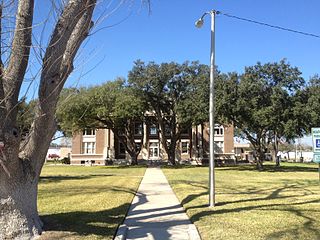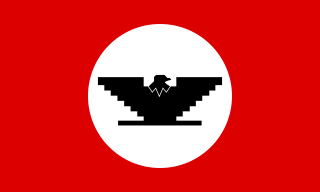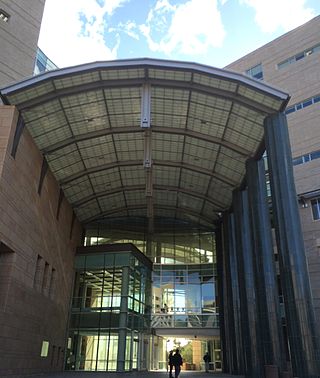
Brooks County is a county in Texas, United States, and Falfurrias is its county seat. Its population was 7,076, approximately 88% Latino per the 2020 census. It is one of Texas's poorest counties.
U.S. Immigration and Customs Enforcement is a federal law enforcement agency under the U.S. Department of Homeland Security. ICE's stated mission is to protect the United States from cross-border crime and undocumented immigration that threaten national security and public safety.

The United States Border Patrol (USBP) is a federal law enforcement agency under the United States Customs and Border Protection (CBP) and is responsible for securing the borders of the United States. According to its website as of 2022, its mission is to "Protect the American people, safeguard our borders, and enhance the nation’s economic prosperity."

The United States border with Mexico is one of the world's "most lethal land borders". Hundreds of migrants die per year as they attempt to cross into the United States from Mexico illegally. The US Border Patrol reported 251 migrant deaths in the fiscal year 2015, which was lower than any year during the period 2000–2014, and reported 247 migrant deaths in fiscal year 2020, lower than any year since 1998. Poverty, gang violence, poor governance, etc. are the main factors as to why migrants cross the US border. US Border Patrol recorded 557 southwest border deaths during fiscal year 2021 and 748 in the first 11 months of fiscal year 2022, the most deaths ever recorded.

United States Customs and Border Protection (CBP) is the largest federal law enforcement agency of the United States Department of Homeland Security. It is the country's primary border control organization, charged with regulating and facilitating international trade, collecting import duties, as well as enforcing U.S. regulations, including trade, customs and immigration. CBP is one of the largest law enforcement agencies in the United States. It has a workforce of more than 45,600 federal agents and officers. It is headquartered in Washington, D.C.

The Mexico–United States border is an international border separating Mexico and the United States, extending from the Pacific Ocean in the west to the Gulf of Mexico in the east. The border traverses a variety of terrains, ranging from urban areas to deserts. It is the most frequently crossed border in the world with approximately 350 million documented crossings annually. Illegal crossing of the border to enter the United States has caused the Mexico–United States border crisis. It is one of two international borders that the United States has, the other being the northern Canada–United States border; Mexico has two other borders: with Belize and with Guatemala.

Arivaca is an unincorporated community in Pima County, Arizona, United States. It is located 11 miles (18 km) north of the Mexican border and 35 miles (56 km) northwest of the port of entry at Nogales. The European-American history of the area dates back at least to 1695, although the community was not founded until 1878. Arivaca has the ZIP code 85601. The 85601 ZIP Code Tabulation Area had a population of 909 at the 2000 census.
Illegal immigration, or unauthorized immigration, occurs when foreign nationals, known as aliens, violate US immigration laws by entering the United States unlawfully, or by lawfully entering but then remaining after the expiration of their visas, parole or temporary protected status.

Operation Gatekeeper was a measure implemented during the presidency of Bill Clinton by the United States Border Patrol, aimed at halting illegal immigration to the United States at the United States–Mexico border near San Diego, California. According to the INS, the goal of Gatekeeper was "to restore integrity and safety to the nation's busiest border."
No More Deaths is an advocacy group based in Tucson and Phoenix, Arizona, United States. The group's stated goal is to end the series of fatalities of undocumented immigrants crossing the desert regions near the Mexico–United States border. Volunteers for the organization provide food, water, and medical aid to people crossing the US-Mexico border through the Arizona desert and offer humanitarian aid to people in Mexico who have been deported from the US.

United States v. Brignoni-Ponce, 422 U.S. 873 (1975), was a case in which the Supreme Court determined it was a violation of the Fourth Amendment for a roving patrol car to stop a vehicle solely on the basis of the driver appearing to be of Mexican descent. A roving patrol car must have articulable facts that allow for an officer to have a reasonable suspicion that the person is carrying illegal aliens beyond their ethnicity. The Court handed down a 9–0 decision that affirmed the Circuit Court's ruling in the case. This case was also the final case that William O. Douglas presided on, as he retired shortly after this case, ending his record 36 years as an Associate Justice.
United States v. Martinez-Fuerte, 428 U.S. 543 (1976), was a decision of the United States Supreme Court that allowed the United States Border Patrol to set up permanent or fixed checkpoints on public highways leading to or away from the Mexican border and that the checkpoints are not a violation of the Fourth Amendment.
The United States Border Patrol operates 71 traffic checkpoints, including 33 permanent traffic checkpoints, near the Mexico–United States border. The stated primary purpose of these inspection stations is to deter illegal immigration and smuggling activities. After the September 11 attacks in 2001, they took on the additional role of terrorism deterrence. These checkpoints are located between 25 and 75 miles of the Mexico–United States border along major U.S. highways; near the southern border of the contiguous United States. Their situation at interior locations allow them to deter illegal activities that may have bypassed official border crossings along the frontier. The checkpoints are divided among nine Border Patrol sectors. There are a number of these checkpoints near the northern border of the contiguous U.S. as well, within 100 miles (160 km) of the Canada–U.S. border.

Buenos Aires National Wildlife Refuge provides 117,107 acres (47,392 ha) of habitat for threatened and endangered plants and animals. This refuge, in Pima County, Arizona, was established in 1985.
Robert N. Krentz Jr. was a prominent rancher in the U.S. state of Arizona. Active in a family cattle ranching business stretching back nearly 100 years, he and his family ranch were inducted into the Arizona Farming and Ranching Hall of Fame in 2008. Krentz was featured several times during the 1990s and 2000s (decade) in media reports regarding the problems surrounding illegal immigration across the Arizona stretch of the United States – Mexico border, particularly regarding its impact on ranching.

Colloquially, a coyote is a person who smuggles immigrants across the Mexico–United States border. The word "coyote" is a loanword from Mexican Spanish that usually refers to a species of North American wild dog (Canis latrans).

Operation Streamline is a joint initiative of the Department of Homeland Security and Department of Justice in the United States, started in 2005, that adopts a "zero-tolerance" approach to unauthorized border-crossing by criminally prosecuting those perpetrating it. Up to 70 people are tried at the same time, sometimes wearing shackles in the courtroom. Entering without inspection is a misdemeanor, and re-entering after deportation is a felony.
In an incident, the 2018 Chimney Canyon shootout on 12 June 2018, at a remote area of southern Arizona, near the community of Arivaca, a United States Border Patrol agent was wounded in an early morning shootout with Mexican smugglers.
Prevention Through Deterrence is a set of policies instituted by the United States to deter the illegal crossing of its southern border with Mexico. First introduced in a document entitled "Border Patrol Strategic Plan of 1994 and Beyond", this policy has since been used to police high-traffic areas of the Mexico–United States border.
Several Indigenous peoples who live on the United States–Mexico border have objected to the construction of a border wall on their territories and the militarization of the border by the United States government. The US–Mexico border crosses several Indigenous territories and divides these communities. The barrier erected between the United States and Mexico cuts through and/or affects at least 29 Indigenous tribes, which include Kumeyaay Nation and Tohono O'odham.











